Information technology — Security techniques — Information security management systems — RequirementsTechnologies de l’information — Techniques de sécurité — Systèmes de management de la sécurité de l’information — Exigences© ISO/IEC 2013INTERNATIONAL STANDARDISO/IEC27001Second edition2013-10-01Reference numberISO/IEC 27001:2013(E)国际信息安全学习联盟www.cncisa.com�
ISO/IEC 27001 信息技术-安全技术-信息安全管理体系-要求 Information technology- Security techniques -Information security management systems-Requirements 国际信息安全学习联盟www.cncisa.com�
ISO/IEC 27001:2013(E) iiiContents PageForeword ........................................................................................................................................................................................................................................0 Introduction ...............................................................................................................................................................................................................1 Scope .................................................................................................................................................................................................................................2 Normative references ......................................................................................................................................................................................3 Terms and definitions .....................................................................................................................................................................................4 Context of the organization .......................................................................................................................................................................4.1 Understanding the organization and its context .......................................................................................................54.2 Understanding the needs and expectations of interested parties ..............................................................54.3 Determining the scope of the information security management system ..........................................54.4 Information security management system .....................................................................................................................75 Leadership ..................................................................................................................................................................................................................75.1 Leadership and commitment .....................................................................................................................................................75.2 Policy ...............................................................................................................................................................................................................75.3 Organizational roles, responsibilities and authorities..........................................................................................96 Planning .........................................................................................................................................................................................................................96.1 Actions to address risks and opportunities ...................................................................................................................96.2 Information security objectives and planning to achieve them ...................................................................137 Support ...........................................................................................................................................................................................................................137.1 Resources .....................................................................................................................................................................................................137.2 Competence ...............................................................................................................................................................................................137.3 Awareness ...................................................................................................................................................................................................137.4 Communication ......................................................................................................................................................................................157.5 Documented information ...............................................................................................................................................................158 Operation .....................................................................................................................................................................................................................178.1 Operational planning and control ..........................................................................................................................................178.2 Information security risk assessment.................................................................................................................................178.3 Information security risk treatment ....................................................................................................................................179 Performance evaluation ...............................................................................................................................................................................179.1 Monitoring, measurement, analysis and evaluation ...............................................................................................179.2 Internal audit ............................................................................................................................................................................................199.3 Management review ...........................................................................................................................................................................1910 Improvement ............................................................................................................................................................................................................2110.1 Nonconformity and corrective action .................................................................................................................................2110.2 Continual improvement ..................................................................................................................................................................21Annex A (normative) Reference control objectives and controls ........................................................................................23Bibliography .............................................................................................................................................................................................................................49国际信息安全学习联盟www.cncisa.com�
目 次 前 言 ............................................................................. 2引 言 ............................................................................ 41 范围 ................................................................................ 62 规范性引用文件 ...................................................................... 63 术语和定义 .......................................................................... 64 组织环境 ............................................................................ 6 5 领导 ................................................................................ 86 规划 ................................................................................ 107 支持 ................................................................................ 148 运行 ................................................................................ 18 9 绩效评价 ............................................................................ 18 10 改进 ............................................................................... 22附 录 A (规范性附录) 参考控制目标和控制措施 ...................................... 24 参考文献 ............................................................................. 50国际信息安全学习联盟www.cncisa.com�
ISO/IEC 27001:2013(E)ForewordISO (the International Organization for Standardization) and IEC (the International Electrotechnical Commission) form the specialized system for worldwide standardization. National bodies that are members of ISO or IEC participate in the development of International Standards through technical committees established by the respective organization to deal with particular fields of technical activity. ISO and IEC technical committees collaborate in fields of mutual interest. Other international organizations, governmental and non-governmental, in liaison with ISO and IEC, also take part in the work. In the field of information technology, ISO and IEC have established a joint technical committee, ISO/IEC JTC 1.International Standards are drafted in accordance with the rules given in the ISO/IEC Directives, Part 2.The main task of the joint technical committee is to prepare International Standards. Draft International Standards adopted by the joint technical committee are circulated to national bodies for voting. Publication as an International Standard requires approval by at least 75 % of the national bodies casting a vote.Attention is drawn to the possibility that some of the elements of this document may be the subject of patent rights. ISO and IEC shall not be held responsible for identifying any or all such patent rights.ISO/IEC 27001 was prepared by Joint Technical Committee ISO/IEC JTC 1, Information technology, Subcommittee SC 27, IT Security techniques.This second edition cancels and replaces the first edition (ISO/IEC 27001:2005), which has been technically revised. 国际信息安全学习联盟www.cncisa.com�
前 言 ISO(国际标准化组织)和IEC(国际电工委员会)是为国际标准化制定专门体制的国际组织。国家机构是ISO或IEC的成员,他们通过各自的组织建立技术委员会参与国际标准的制定,来处理特定领域的技术活动。ISO和IEC技术委员会在共同感兴趣的领域合作。其他国际组织、政府和非政府等机构,通过联络ISO和IEC参与这项工作。ISO和IEC已经在信息技术领域建立了一个联合技术委员会ISO/IEC JTC1。 国际标准的制定遵循ISO/IEC 导则第2部分的规则。 联合技术委员会的主要任务是起草国际标准,并将国际标准草案提交给国家机构投票表决。国际标准的出版发行必须至少75%以上的成员投票通过。 本文件中的某些内容有可能涉及一些专利权问题,这一点应该引起注意。ISO和IEC不负责识别任何这样的专利权问题。 ISO/IEC 27001 由联合技术委员会ISO/IEC JTC1(信息技术)分委员会SC27(安全技术)起草。 第二版进行了技术上的修订,并取消和替代第一版(ISO/IEC 27001:2005)。 国际信息安全学习联盟www.cncisa.com�
ISO/IEC 27001:2013(E)0 Introduction0.1 GeneralThis International Standard has been prepared to provide requirements for establishing, implementing, maintaining and continually improving an information security management system. The adoption of an information security management system is a strategic decision for an organization. The establishment and implementation of an organization’s information security management system is influenced by the organization’s needs and objectives, security requirements, the organizational processes used and the size and structure of the organization. All of these influencing factors are expected to change over time.The information security management system preserves the confidentiality, integrity and availability of information by applying a risk management process and gives confidence to interested parties that risks are adequately managed.It is important that the information security management system is part of and integrated with the organization’s processes and overall management structure and that information security is considered in the design of processes, information systems, and controls. It is expected that an information security management system implementation will be scaled in accordance with the needs of the organization.This International Standard can be used by internal and external parties to assess the organization’s ability to meet the organization’s own information security requirements.The order in which requirements are presented in this International Standard does not reflect their importance or imply the order in which they are to be implemented. The list items are enumerated for reference purpose only.ISO/IEC 27000 describes the overview and the vocabulary of information security management systems, referencing the information security management system family of standards (including ISO/IEC 27003[2], ISO/IEC 27004[3] and ISO/IEC 27005[4]), with related terms and definitions. 0.2 Compatibility with other management system standardsThis International Standard applies the high-level structure, identical sub-clause titles, identical text, common terms, and core definitions defined in Annex SL of ISO/IEC Directives, Part 1, Consolidated ISO Supplement, and therefore maintains compatibility with other management system standards that have adopted the Annex SL.This common approach defined in the Annex SL will be useful for those organizations that choose to operate a single management system that meets the requirements of two or more management system standards. 国际信息安全学习联盟www.cncisa.com�
引 言 0.1 总则 本标准用于为建立、实施、保持和持续改进信息安全管理体系提供要求。采用信息安全管理体系是组织的一项战略性决策。一个组织信息安全管理体系的建立和实施受其需要和目标、安全要求、所采用的过程以及组织的规模和结构的影响。所有这些影响因素会不断发生变化。 信息安全管理体系通过应用风险管理过程来保持信息的保密性、完整性和可用性,以充分管理风险并给予相关方信心。 信息安全管理体系是组织过程和整体管理结构的一部分并与其整合在一起是非常重要的。信息安全在设计过程、信息系统、控制措施时就要考虑信息安全。按照组织的需要实施信息安全管理体系,是本标准所期望的。 本标准可被内部和外部相关方使用,评估组织的能力是否满足组织自身信息安全要求。 本标准中要求的顺序并不能反映他们的重要性或意味着他们的实施顺序。列举的条目仅用于参考目的。 ISO/IEC27000描述了信息安全管理体系的概述和词汇,参考了信息安全管理体系标准族(包括ISO/IEC 27003、ISO/IEC 27004和ISO/IEC 27005)以及相关的术语和定义。 0.2 与其他管理体系的兼容性 本标准应用了ISO/IEC 导则第一部分ISO补充部分附录SL中定义的高层结构、相同的子章节标题、相同文本、通用术语和核心定义。因此保持了与其它采用附录SL的管理体系标准的兼容性。 附录SL定义的通用方法对那些选择运作单一管理体系(可同时满足两个或多个管理体系标准要求)的组织来说是十分有益的。 国际信息安全学习联盟www.cncisa.com�
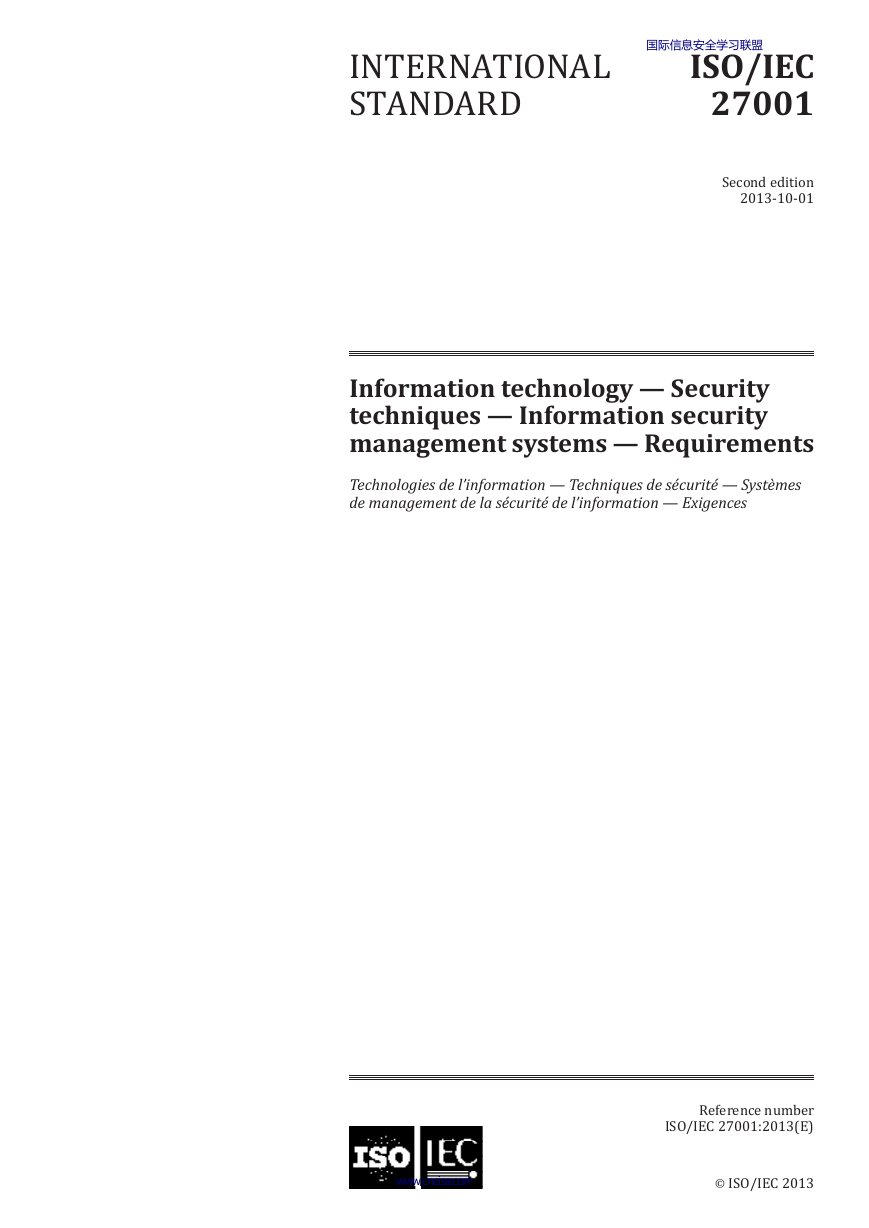
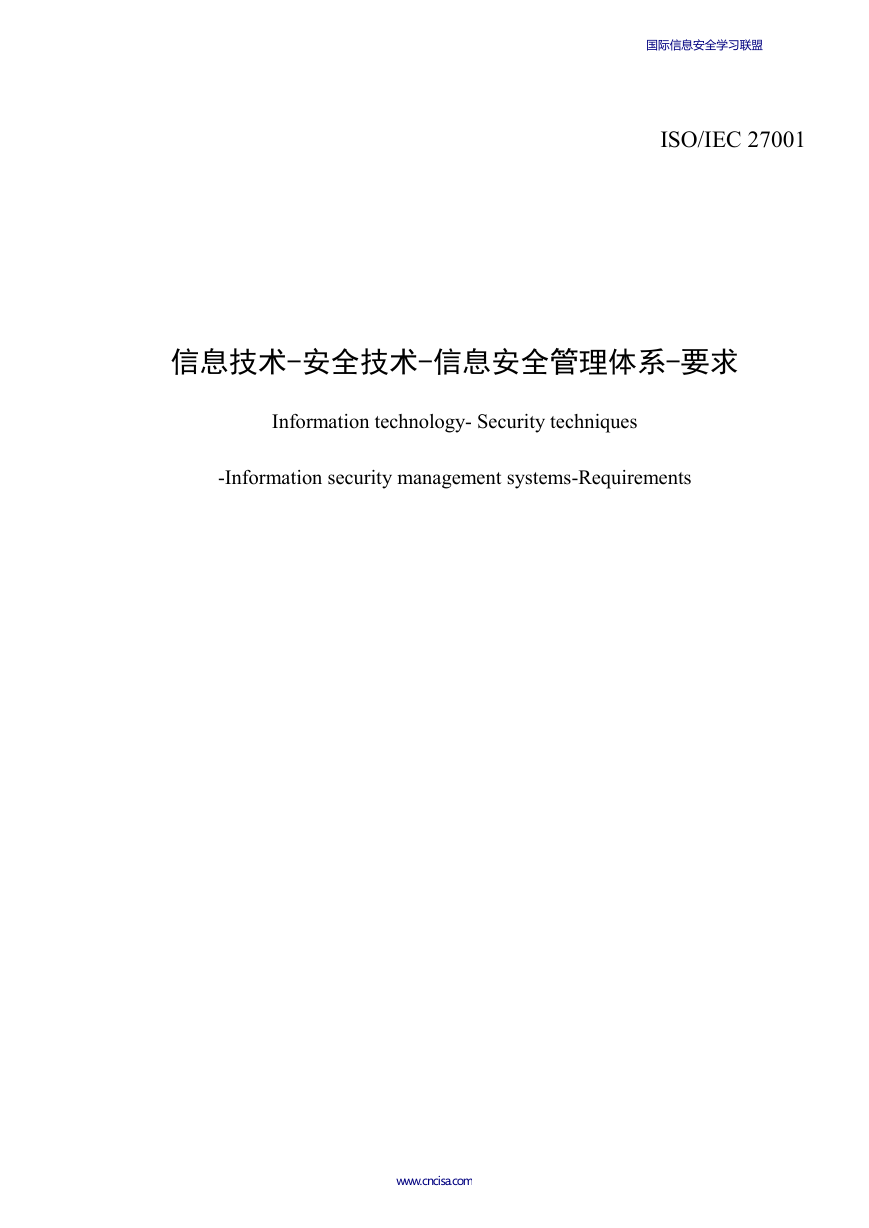
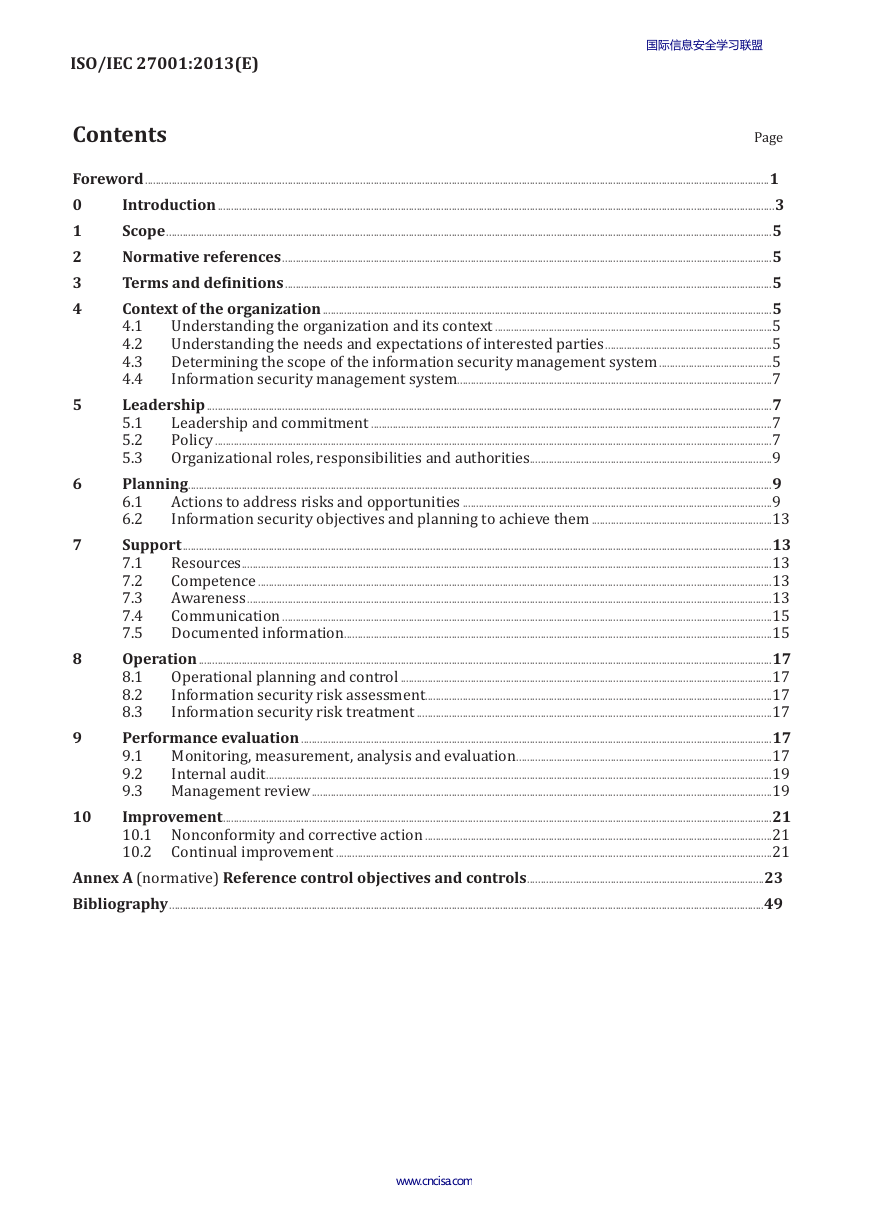


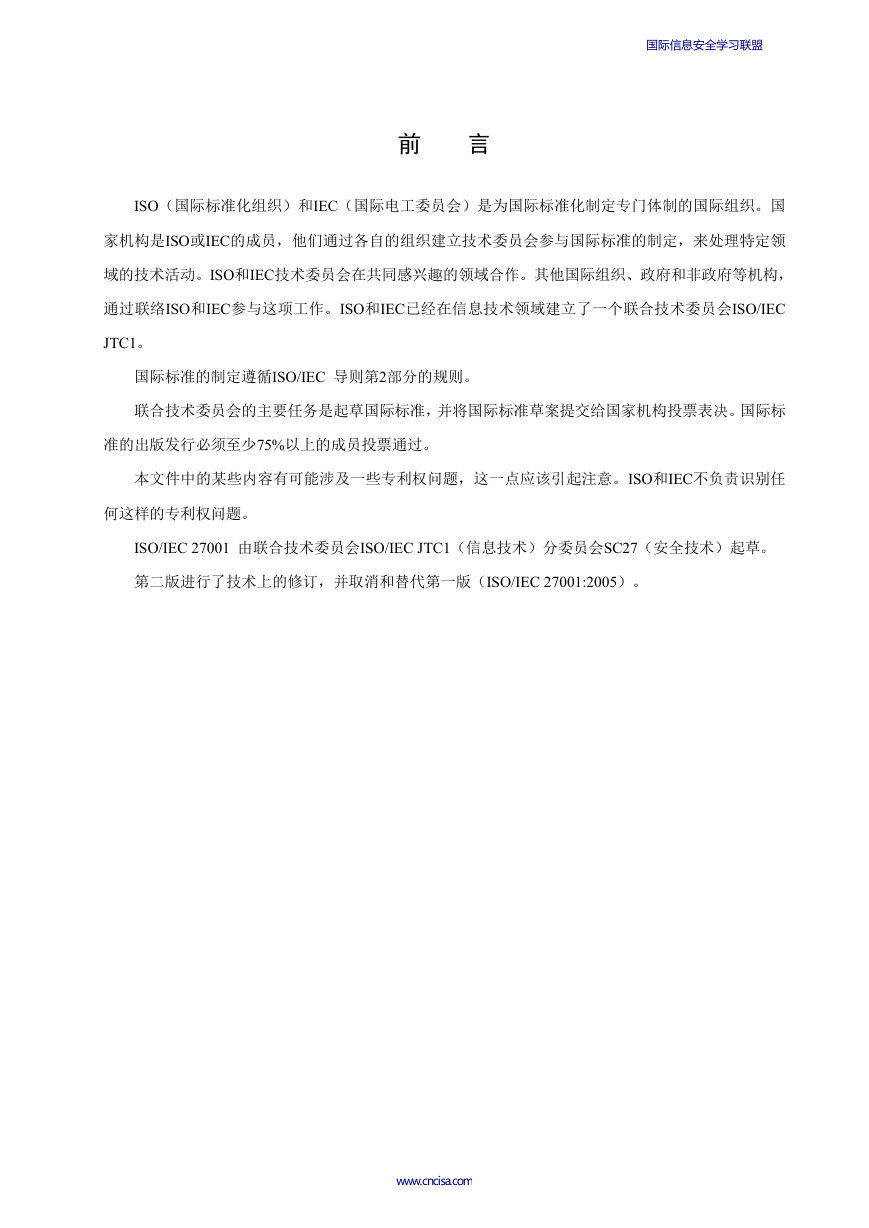

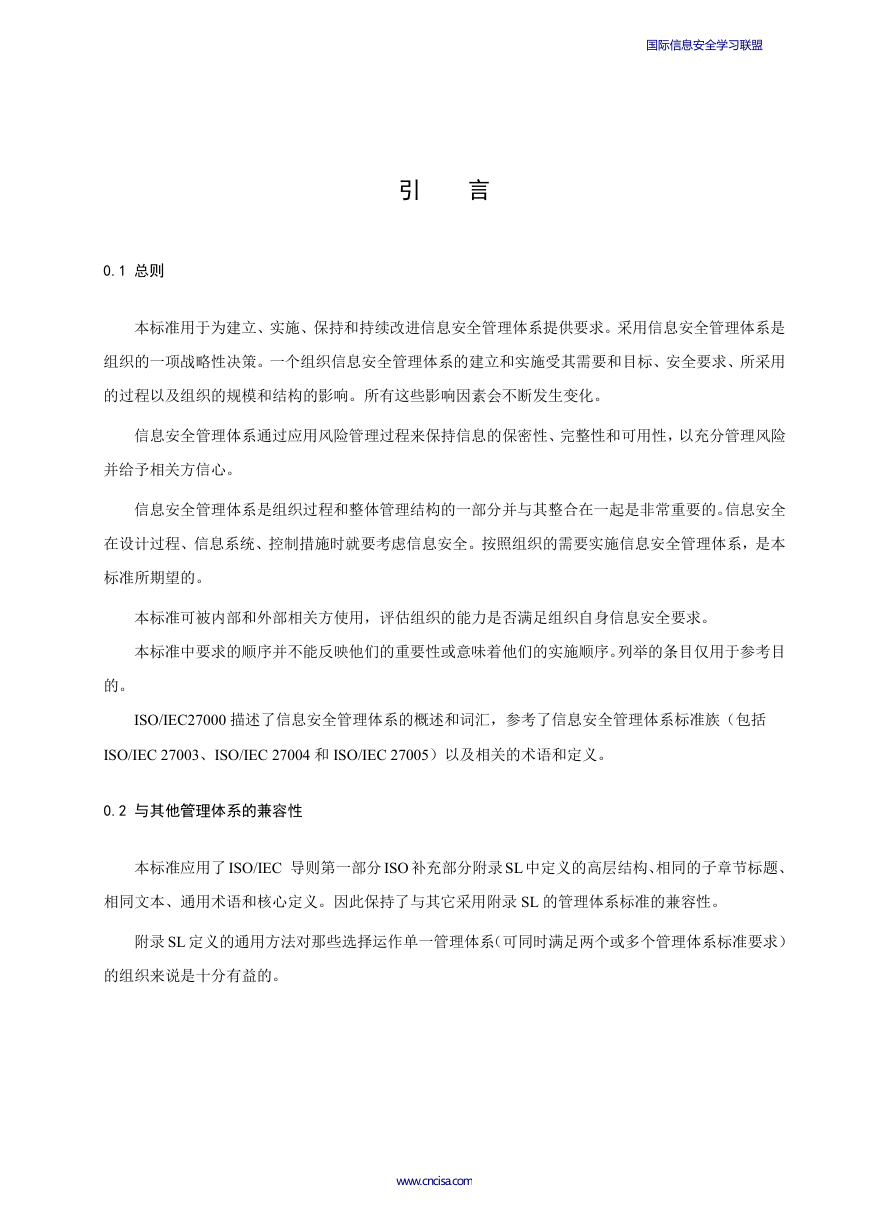








 2023年江西萍乡中考道德与法治真题及答案.doc
2023年江西萍乡中考道德与法治真题及答案.doc 2012年重庆南川中考生物真题及答案.doc
2012年重庆南川中考生物真题及答案.doc 2013年江西师范大学地理学综合及文艺理论基础考研真题.doc
2013年江西师范大学地理学综合及文艺理论基础考研真题.doc 2020年四川甘孜小升初语文真题及答案I卷.doc
2020年四川甘孜小升初语文真题及答案I卷.doc 2020年注册岩土工程师专业基础考试真题及答案.doc
2020年注册岩土工程师专业基础考试真题及答案.doc 2023-2024学年福建省厦门市九年级上学期数学月考试题及答案.doc
2023-2024学年福建省厦门市九年级上学期数学月考试题及答案.doc 2021-2022学年辽宁省沈阳市大东区九年级上学期语文期末试题及答案.doc
2021-2022学年辽宁省沈阳市大东区九年级上学期语文期末试题及答案.doc 2022-2023学年北京东城区初三第一学期物理期末试卷及答案.doc
2022-2023学年北京东城区初三第一学期物理期末试卷及答案.doc 2018上半年江西教师资格初中地理学科知识与教学能力真题及答案.doc
2018上半年江西教师资格初中地理学科知识与教学能力真题及答案.doc 2012年河北国家公务员申论考试真题及答案-省级.doc
2012年河北国家公务员申论考试真题及答案-省级.doc 2020-2021学年江苏省扬州市江都区邵樊片九年级上学期数学第一次质量检测试题及答案.doc
2020-2021学年江苏省扬州市江都区邵樊片九年级上学期数学第一次质量检测试题及答案.doc 2022下半年黑龙江教师资格证中学综合素质真题及答案.doc
2022下半年黑龙江教师资格证中学综合素质真题及答案.doc